Small overlap front: driver-side
Rating applies to 2007-17 models
Tested vehicle: 2012 Jeep Patriot Sport 4-door 4wd
The Jeep Patriot was introduced in the 2007 model year.
| Evaluation criteria | Rating |
|---|---|
| Structure and safety cage | |
| Driver injury measures | |
| Head/neck | |
| Chest | |
| Hip/thigh | |
| Lower leg/foot | |
|
Driver restraints and dummy kinematics
The dummy’s head barely contacted the frontal airbag before sliding off the left side as the steering column moved 21 cm upward and 15 cm to the right, resulting in little airbag cushioning for the chest and leaving the head vulnerable to contact with forward side structure. Additionally, the seat belt allowed excessive forward excursion of the dummy’s head and torso, and the driver's seat tipped forward and toward the B-pillar. The side curtain airbag did not deploy, leaving the dummy's head vulnerable to contacts with side structure and outside objects. | |
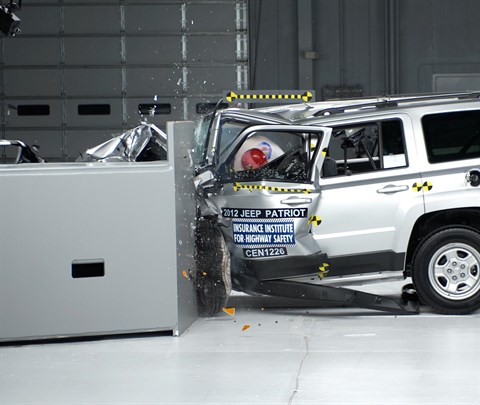
Action shot taken during the small overlap frontal crash test.
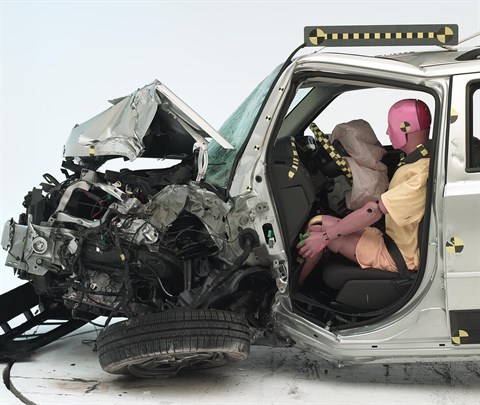
The dummy's position in relation to the door frame, steering wheel, and instrument panel after the crash test indicates that the driver's survival space wasn't maintained well.
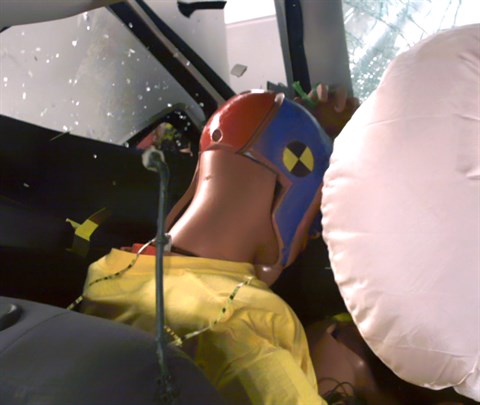
During the crash, the dummy's head barely contacted the airbag before sliding off to the left, and the seat belt allowed the dummy to move too far forward, as is evident from the gap between the seat back and the dummy's torso.
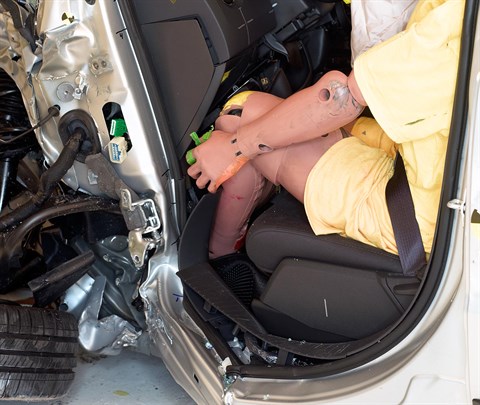
Extensive intrusion of the door hinge pillar and instrument panel contributed to a high risk of injury to the left lower leg and a moderate risk to the left thigh and right lower leg.
Moderate overlap front: original test
Rating applies to 2007-17 models
Tested vehicle: 2008 Jeep Patriot Sport 4-door 4wd
The Jeep Patriot was introduced in the 2007 model year.
| Evaluation criteria | Rating |
|---|---|
| Overall evaluation | |
| Structure and safety cage | |
| Driver injury measures | |
| Head/neck | |
| Chest | |
| Leg/foot, left | |
| Leg/foot, right | |
| Driver restraints and dummy kinematics | |
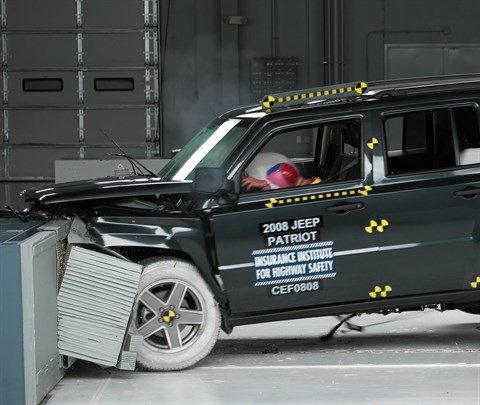
Action shot taken during the frontal offset crash test.
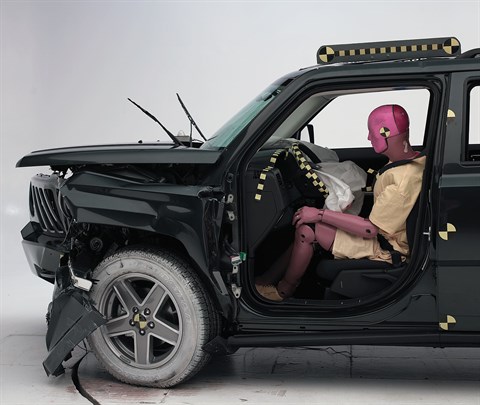
The dummy's position in relation to the steering wheel and instrument panel after the crash test indicates that the driver's survival space was maintained well.
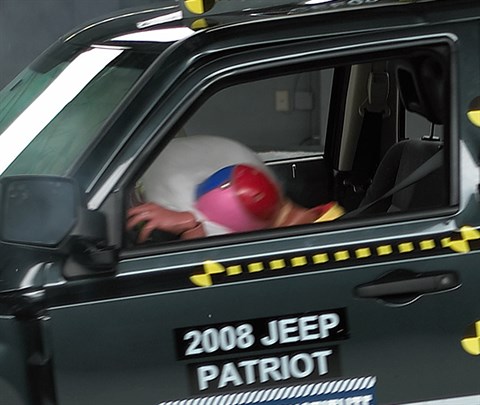
A high head acceleration occurred when the dummy's head hit the steering wheel through the airbag.
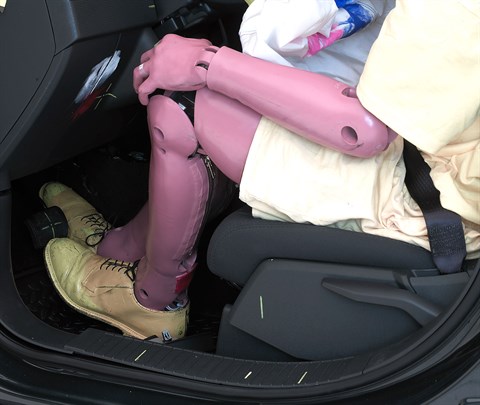
Intrusion into the driver's space was minimal, and all leg and foot injury measures were low.
Side: original test
Rating applies to 2014-17 models
Tested vehicle: 2008 Jeep Patriot Sport 4-door 4wd with standard front and rear head curtain airbags and optional front seat-mounted torso airbags
The Jeep Patriot was introduced in the 2007 model year. Seat-mounted torso airbags for front seat occupants became standard beginning with 2014 models (they had been optional in earlier models). Front and rear side curtain airbags were standard in all model years.
The side impact crash test ratings also apply to Jeep Compass, a vehicle similar to the Patriot but with a different roofline, beginning with 2007 models.
| Evaluation criteria | Rating |
|---|---|
| Overall evaluation | |
| Structure and safety cage | |
| Driver injury measures | |
| Head/neck | |
| Torso | |
| Pelvis/leg | |
| Driver head protection | |
| Rear passenger injury measures | |
| Head/neck | |
| Torso | |
| Pelvis/leg | |
| Rear passenger head protection | |
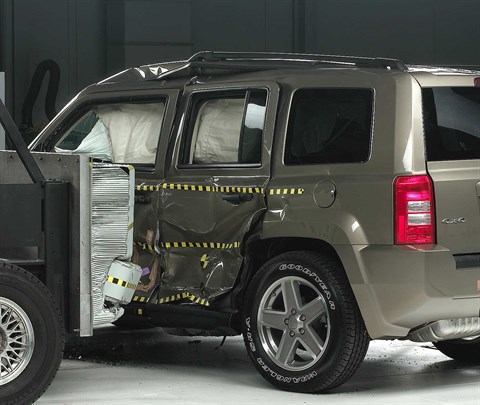
View of the vehicle and barrier just after the crash test (applicable to 2007-17 Jeep Compass built before January 2017 and 2007-17 Jeep Patriot equipped with both side curtain head-protection airbags and front seat side torso airbags).

View of the vehicle after the crash with doors removed, showing the side airbags and damage to the occupant compartment.
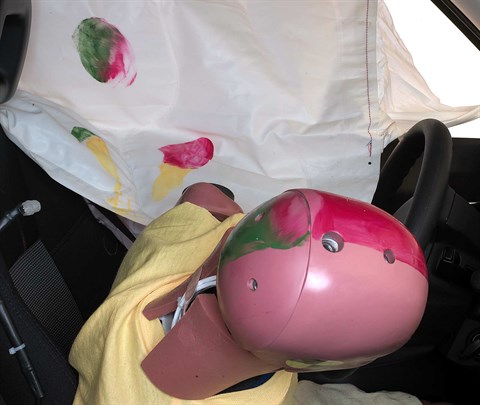
Smeared greasepaint shows where the driver dummy's head was protected from being hit by hard structures by the side curtain airbag (side torso airbag is hidden behind the curtain airbag).
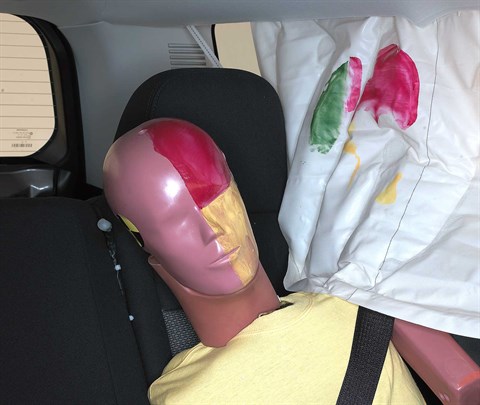
Smeared greasepaint shows where the rear passenger dummy’s head was protected by the side airbag.
Roof strength
Rating applies to 2007-17 models
Tested vehicle: 2009 Jeep Patriot Sport 4-door 2wd
(Curb weight from 2008 Jeep Patriot Sport 4-door 4wd)
| Overall evaluation | |
|---|---|
| Curb weight | 3,393 lbs |
| Peak force | 14,419 lbs |
| Strength-to-weight ratio | 4.25 |
Head restraints & seats
Seat type: Manual cloth seats AHR
| Overall evaluation | |
|---|---|
| Dynamic rating | |
| Seat/head restraint geometry |
About the head restraint & seat test
Currently, IIHS tests apply only to front seats.
Headlights
Trim level(s)
- All trims
| Evaluation criteria | Rating |
|---|---|
| Low-beam headlight type | Halogen reflector |
| High-beam headlight type | Halogen reflector |
| Curve-adaptive? | No |
| High-beam assist? | No |
|
Overall rating | |
| Distance at which headlights provide at least 5 lux illumination: | |
Low beams
On the straightaway, visibility was inadequate on both sides of the road. On curves, visibility was inadequate in all 4 tests.
The low beams never exceeded glare limits.
High beams
On the straightaway, visibility was fair on the right side of the road and inadequate on the left side. On curves, visibility was inadequate in all 4 tests.
Child seat anchors
Rating applies to 2016-17 models
| Evaluation criteria | Rating |
|---|---|
| Overall evaluation | |
| Vehicle trim | Sport |
| Seat type | cloth |
This vehicle has 2 rear seating positions with complete child seat attachment (LATCH) hardware.
It has 1 additional seating position with a tether anchor only.
| Evaluation criteria | Rating |
|---|---|
| Overall evaluation | |
| Vehicle trim | Sport |
| Seat type | cloth |
| Rating icon | Rating |
|---|---|
| G | Good |
| A | Acceptable |
| M | Marginal |
| P | Poor |
| Seating positions that rely on borrowed lower anchors or have only a tether anchor available are not rated. | |
thether anchor symbol | Tether anchor |
lower anchor symbol | Lower anchors |
| Lower anchor(s) can be borrowed from adjacent positions(s) | |
| No hardware available |
Details by seating position
| Position | Rating |
|---|---|
| 1 | |
| Tether anchor | |
| easy-to-find location | |
| other hardware could be confused for anchor | |
| Lower anchors | |
| too deep in seat | |
| not too much force needed to attach | |
| easy to maneuver around anchors | |
| 2 | |
| Tether anchor | |
| easy-to-find location | |
| other hardware could be confused for anchor | |
| Lower anchors | |
| none available | |
| 3 | |
| Tether anchor | |
| easy-to-find location | |
| other hardware could be confused for anchor | |
| Lower anchors | |
| too deep in seat | |
| not too much force needed to attach | |
| easy to maneuver around anchors |
